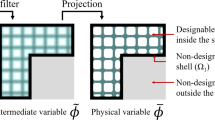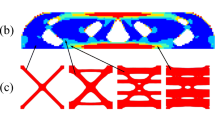Abstract
This paper presents a topology optimization method for a multi-phase shell-infill composite, accounting for the coated shell and graded multi-phase microstructural infill. The method builds upon extended multi-phase density-based topology optimization approaches, and it consists of two major steps: (1) general structural configuration design of the shell-base composite structure and (2) detailed design of the graded multi-phase infill architecture. An erosion-based interface identification method is adopted to evolve the general structural configuration with a coated shell. Then the maximum and minimum length scale control constraints are simultaneously imposed on each phase material to generate graded multi-phase porous structures in the base region. The whole design process is performed on a full-size finite element analysis and only involves standard filtering operations. It avoids the separation of scales and guarantees the connectivity of microstructures. Several numerical examples for minimum compliance are presented, and a post-processing method is proposed to smooth the design boundaries when extracting CAD models for additive manufacturing. Eventually, the manufacturability of the post-processed prototype is verified with a multi-material 3D printer, which further illustrates the applicability of the proposed method.

















Similar content being viewed by others
Data availability
The raw/processed data required to reproduce these findings cannot be shared at this time as the data also forms part of an ongoing study.
References
Gibson LJ, Ashby MF (1999) Cellular solids: structure and properties. Cambridge University Press, Cambridge
Ha CS, Lakes RS, Plesha ME (2018) Design, fabrication, and analysis of lattice exhibiting energy absorption via snap-through behavior. Mater Des 141:426–437
Clausen A, Aage N, Sigmund O (2016) Exploiting additive manufacturing infill in topology optimization for improved buckling load. Engineering 2:250–257
Wu J, Aage N, Westermann R, Sigmund O (2017) Infill optimization for additive manufacturing—approaching bone-like porous structures. IEEE Trans Visual Comput Graphics 24:1127–1140
Bendsoe MP, Sigmund O (2013) Topology optimization: theory, methods, and applications. Springer, Berlin
Zheng Y, Wang Y, Lu X, Liao Z, Qu J (2020) Evolutionary topology optimization for mechanical metamaterials with auxetic property. Int J Mech Sci 179:105638
Li H, Li H, Xiao M, Zhang Y, Fu J, Gao L (2020) Robust topology optimization of thermoelastic metamaterials considering hybrid uncertainties of material property. Compos Struct 248:112477
Xu S, Liu J, Zou B, Li Q, Ma Y (2021) Stress constrained multi-material topology optimization with the ordered SIMP method. Comput Methods Appl Mech Eng 373:113453
Zheng Y, Wang Y, Lu X, Zheng J, Qu J (2021) Topology optimisation for isotropic mechanical metamaterials considering material uncertainties. Mech Mater 155:103742
Ye M, Li H, Cai X, Gao L, Zhang A, Zhao Z (2021) Progressive design of gradually stiffer metamaterial using surrogate model. Compos Struct 264:113715
Pham Q-H, Phan D-H (2020) Polygonal topology optimization for Reissner–Mindlin plates. Eng Comput 38:141–154
Cui M, Luo C, Li G, Pan M (2021) The parameterized level set method for structural topology optimization with shape sensitivity constraint factor. Eng Comput 37:855–872
Yu H, Huang J, Zou B, Shao W, Liu J (2020) Stress-constrained shell-lattice infill structural optimisation for additive manufacturing. Virtual Phys Prototyping 15:35–48
Das S, Sutradhar A (2020) Multi-physics topology optimization of functionally graded controllable porous structures: application to heat dissipating problems. Mater Des 193:108775
Xu S, Liu J, Huang J, Zou B, Ma Y (2021) Multi-scale topology optimization with shell and interface layers for additive manufacturing. Addit Manuf 37:101698
Sigmund O (1994) Materials with prescribed constitutive parameters: an inverse homogenization problem. Int J Solids Struct 31:2313–2329
Vicente W, Zuo Z, Pavanello R, Calixto T, Picelli R, Xie Y (2016) Concurrent topology optimization for minimizing frequency responses of two-level hierarchical structures. Comput Methods Appl Mech Eng 301:116–136
Wang F, Sigmund O (2020) Numerical investigation of stiffness and buckling response of simple and optimized infill structures. Struct Multidiscip Optim 61:2629–2639
Wang Y, Wang MY, Chen F (2016) Structure-material integrated design by level sets. Struct Multidiscip Optim 54:1145–1156
Fu J, Li H, Gao L, Xiao M (2019) Design of shell-infill structures by a multiscale level set topology optimization method. Comput Struct 212:162–172
Li H, Luo Z, Gao L, Walker P (2018) Topology optimization for functionally graded cellular composites with metamaterials by level sets. Comput Methods Appl Mech Eng 328:340–364
Yan X, Xu Q, Huang D, Zhong Y, Huang X (2019) Concurrent topology design of structures and materials with optimal material orientation. Compos Struct 220:473–480
Lee J, Kim D, Nomura T, Dede EM, Yoo J (2018) Topology optimization for continuous and discrete orientation design of functionally graded fiber-reinforced composite structures. Compos Struct 201:217–233
Li H, Luo Z, Gao L, Qin Q (2018) Topology optimization for concurrent design of structures with multi-patch microstructures by level sets. Comput Methods Appl Mech Eng 331:536–561
Gao J, Luo Z, Li H, Gao L (2019) Topology optimization for multiscale design of porous composites with multi-domain microstructures. Comput Methods Appl Mech Eng 344:451–476
Zhang Y, Xiao M, Gao L, Gao J, Li H (2020) Multiscale topology optimization for minimizing frequency responses of cellular composites with connectable graded microstructures. Mech Syst Signal Process 135:106369
Groen JP, Wu J, Sigmund O (2019) Homogenization-based stiffness optimization and projection of 2D coated structures with orthotropic infill. Comput Methods Appl Mech Eng 349:722–742
Groen JP, Sigmund O (2018) Homogenization-based topology optimization for high-resolution manufacturable microstructures. Int J Numer Methods Eng 113:1148–1163
Kim D, Lee J, Nomura T, Dede EM, Yoo J, Min S (2020) Topology optimization of functionally graded anisotropic composite structures using homogenization design method. Comput Methods Appl Mech Eng 369:113220
Liu P, Kang Z, Luo Y (2020) Two-scale concurrent topology optimization of lattice structures with connectable microstructures. Addit Manuf 36:101427
Wang Y, Zhang L, Daynes S, Zhang H, Feih S, Wang MY (2018) Design of graded lattice structure with optimized mesostructures for additive manufacturing. Mater Des 142:114–123
Garner E, Kolken HM, Wang CC, Zadpoor AA, Wu J (2019) Compatibility in microstructural optimization for additive manufacturing. Addit Manuf 26:65–75
Luo Y, Hu J, Liu S (2021) Self-connected multi-domain topology optimization of structures with multiple dissimilar microstructures. Struct Multidiscip Optim 64:125–140
Alexandersen J, Lazarov BS (2015) Topology optimisation of manufacturable microstructural details without length scale separation using a spectral coarse basis preconditioner. Comput Methods Appl Mech Eng 290:156–182
Dou S (2020) A projection approach for topology optimization of porous structures through implicit local volume control. Struct Multidiscip Optim 62:835–850
Li H, Gao L, Li H, Tong H (2020) Spatial-varying multi-phase infill design using density-based topology optimization. Comput Methods Appl Mech Eng 372:113354
Clausen A, Aage N, Sigmund O (2015) Topology optimization of coated structures and material interface problems. Comput Methods Appl Mech Eng 290:524–541
Clausen A, Andreassen E, Sigmund O (2017) Topology optimization of 3D shell structures with porous infill. Acta Mech Sin 33:778–791
Luo Y, Li Q, Liu S (2019) Topology optimization of shell–infill structures using an erosion-based interface identification method. Comput Methods Appl Mech Eng 355:94–112
Wang Y, Kang Z (2018) A level set method for shape and topology optimization of coated structures. Comput Methods Appl Mech Eng 329:553–574
Fu J, Li H, Xiao M, Gao L, Chu S (2019) Topology optimization of shell-infill structures using a distance regularized parametric level-set method. Struct Multidiscip Optim 59:249–262
Hoang V-N, Nguyen N-L, Nguyen-Xuan H (2020) Topology optimization of coated structure using moving morphable sandwich bars. Struct Multidiscip Optim 61:491–506
Wadbro E, Niu B (2019) Multiscale design for additive manufactured structures with solid coating and periodic infill pattern. Comput Methods Appl Mech Eng 357:112605
Wu J, Clausen A, Sigmund O (2017) Minimum compliance topology optimization of shell–infill composites for additive manufacturing. Comput Methods Appl Mech Eng 326:358–375
Qiu W, Jin P, Jin S, Wang C, Xia L, Zhu J et al (2020) An evolutionary design approach to shell-infill structures. Addit Manuf 34:101382
Bandyopadhyay A, Heer B (2018) Additive manufacturing of multi-material structures. Mater Sci Eng R Rep 129:1–16
Wang F, Lazarov BS, Sigmund O (2011) On projection methods, convergence and robust formulations in topology optimization. Struct Multidiscip Optim 43:767–784
Diaz A, Sigmund O (1995) Checkerboard patterns in layout optimization. Struct Optim 10:40–45
Lazarov BS, Sigmund O (2011) Filters in topology optimization based on Helmholtz-type differential equations. Int J Numer Methods Eng 86:765–781
Svanberg K (1987) The method of moving asymptotes—a new method for structural optimization. Int J Numer Methods Eng 24:359–373
Li H, Gao L, Li H, Li X, Tong H (2021) Full-scale topology optimization for fiber-reinforced structures with continuous fiber paths. Comput Methods Appl Mech Eng 377:113668
Fernández E, Yang K-K, Koppen S, Alarcón P, Bauduin S, Duysinx P (2020) Imposing minimum and maximum member size, minimum cavity size, and minimum separation distance between solid members in topology optimization. Comput Methods Appl Mech Eng 368:113157
Da D, Xia L, Li G, Huang X (2018) Evolutionary topology optimization of continuum structures with smooth boundary representation. Struct Multidiscip Optim 57:2143–2159
Acknowledgements
This research is partially supported by the National Natural Science Foundation of China (52075195), the Fundamental Research Funds for the Central Universities through Program no. 2172019kfyXJJS078 and 2019kfyXKJC042, and the Program for HUST Academic Frontier Youth Team (No. 2017QYTD04).
Author information
Authors and Affiliations
Corresponding author
Additional information
Publisher's Note
Springer Nature remains neutral with regard to jurisdictional claims in published maps and institutional affiliations.
Rights and permissions
Springer Nature or its licensor (e.g. a society or other partner) holds exclusive rights to this article under a publishing agreement with the author(s) or other rightsholder(s); author self-archiving of the accepted manuscript version of this article is solely governed by the terms of such publishing agreement and applicable law.
About this article
Cite this article
Li, H., Li, H., Gao, L. et al. Topology optimization of multi-phase shell-infill composite structure for additive manufacturing. Engineering with Computers 40, 1049–1064 (2024). https://doi.org/10.1007/s00366-023-01837-4
Received:
Accepted:
Published:
Issue Date:
DOI: https://doi.org/10.1007/s00366-023-01837-4




